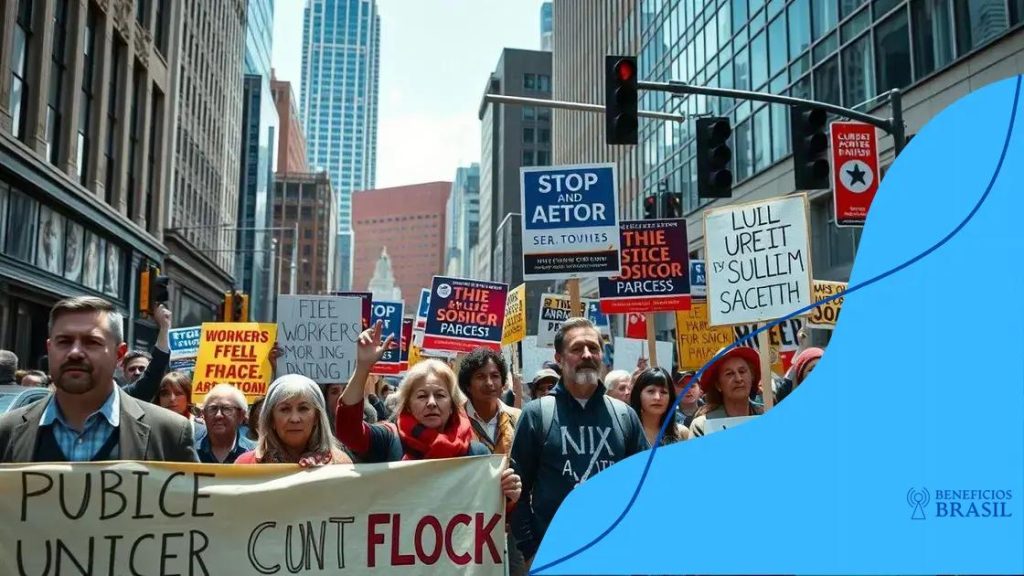Public sector union solidarity protests: what you need to know

Public sector union solidarity protests are organized efforts by workers to advocate for their rights, demanding fair wages, job security, and better working conditions, while gaining support from the community to amplify their impact.
Public sector union solidarity protests are becoming increasingly prominent, attracting attention and support across various communities. But what drives these movements, and how do they shape our society? Let’s delve into the key factors behind this surge in activism.
Understanding the role of public sector unions
Understanding the role of public sector unions is essential to grasping their impact on society and the workforce. These unions advocate for workers’ rights and play a vital role in negotiating better pay and working conditions.
Public sector unions represent a diverse group, including teachers, healthcare workers, and government employees. They mobilize members to fight for fair treatment and comprehensive benefits. By doing so, they help ensure that both workers and the public receive valuable services.
Key Functions of Public Sector Unions
These unions serve several important functions:
- Collective Bargaining: They negotiate terms of employment, such as salary and benefits, on behalf of their members.
- Representation: Unions represent their members in disputes and grievances, providing legal support when needed.
- Advocacy: Public sector unions advocate for policies that promote the interests of their members and the public.
By enhancing job security and improving work environments, unions contribute positively to societal advancement. Understanding their significance helps highlight the continuous struggle for workers’ rights and how public sector unions stand at the forefront of this movement.
Furthermore, public sector unions help enhance the quality of services offered by the government. By ensuring that workers are well-compensated and motivated, they contribute to better public services. Strong, fair representation leads to an enhanced workforce, which directly benefits society.
History of solidarity protests in the public sector

The history of solidarity protests in the public sector reflects a long-standing tradition of workers uniting for their rights. From the early 20th century, public sector employees have organized to demand fair wages and working conditions.
These protests often arise in times of economic hardship or when workers feel their voices are not heard. A turning point in this history was during the 1930s, when many public workers began to formally unionize, seeking better representation.
Key Milestones in Public Sector Solidarity
Several significant events have marked the evolution of these protests:
- The rise of labor unions: In the 1930s, the establishment of labor laws allowed public sector workers to organize.
- Major strikes: Events like the 1970 postal strike in the UK and the 1981 air traffic controllers’ strike in the USA showcased the power of collective action.
- Recent movements: In recent years, movements like the Fight for $15 have brought public sector workers together to fight for minimum wage increases.
These protests highlight the ongoing struggle for workers’ rights and have led to significant policy changes. Throughout the years, public sector unions have become a vital part of the labor landscape, advocating for both their members and the communities they serve.
Solidarity protests are not just about workers’ rights; they reflect broader social issues such as equality and justice. Public sector unions often stand in solidarity with other movements, understanding that their fight is interconnected with the fight for social justice.
Key issues driving current protests
Several key issues are driving current protests in the public sector. Many workers are uniting to address concerns that affect their jobs and communities.
One major issue is the demand for better wages. Public sector employees often feel that their salaries do not reflect their hard work and the essential services they provide. Many protests are aimed at advocating for fair pay that aligns with the cost of living.
Underlying Issues Leading to Protests
In addition to wage concerns, other critical issues include:
- Job security: Many public sector workers face uncertainty in their positions, leading to calls for more stable employment.
- Working conditions: Poor working conditions can impact morale and productivity, prompting protests demanding safer environments.
- Access to benefits: Healthcare and retirement benefits are crucial for public sector employees. Workers are advocating for stronger benefits that sustain their well-being.
Furthermore, ongoing issues of systemic inequality play a significant role in uniting workers. Many protests focus on addressing disparities in pay and treatment based on race, gender, and other factors. These inequalities motivate individuals to stand up for their rights and push for greater equity in the workplace.
Lastly, the impact of recent political changes and budget cuts has fueled anger and frustration among public sector workers. The feeling that their voices are not being heard drives many to take part in solidarity protests.
Impact of these protests on policy and governance

The impact of these protests on policy and governance is significant and often far-reaching. When public sector workers come together to protest, they raise awareness about critical issues that affect their jobs and communities.
One major way these protests influence policy is through increased visibility. Lawmakers and the public take notice when large groups voice their concerns. This attention can lead to discussions in legislative bodies, raising the importance of urgent issues like fair pay, job security, and workplace safety.
Changes in Legislation
As protests highlight specific demands, policies can change in response. For example, various regions have seen:
- Wage increases: Many times, protests lead to negotiations resulting in better salary conditions for public sector workers.
- Enhanced benefits: Unions may successfully lobby for expanded health care or retirement benefits as a direct response to protest demands.
- Policy reforms: Protests can lead to broader changes, such as improved workplace standards and protections for all workers, not just union members.
The protests also empower workers by promoting solidarity and collective action. When they unite and take to the streets, they send a clear message to policymakers: the voices of public workers matter. This collective force can alter the trajectory of governance by making labor issues a central topic in political discourse.
Additionally, the impact extends to public perception. Protests can shift how communities view public sector workers and their contributions. This shift can lead to increased support for labor movements, as citizens recognize the importance of fair work environments.
How community support amplifies union efforts
Community support plays a vital role in amplifying union efforts, especially during protests and advocacy campaigns. When local communities stand in solidarity with public sector unions, their collective voice becomes significantly louder.
One of the most noticeable effects of community backing is increased visibility. When community members join unions in their efforts, it sends a clear message to policymakers that these issues are not isolated to just workers but affect the entire community. This shared concern encourages politicians to take action.
The Importance of Solidarity
Solidarity with unions can take many forms:
- Participation in rallies: Community members participating in union rallies show support and boost morale among workers.
- Sharing information: Local supporters can help spread awareness and educate others about union efforts and the reasons behind them.
- Financial donations: Contributions from the community can help sustain union activities, providing resources for events and campaigns.
Moreover, when unions and community groups collaborate, they can address broader social issues. For instance, many unions have allied with housing activists to fight for affordable housing, thereby expanding their reach and impact. This collaboration showcases how labor struggles can intersect with other vital issues like education, health care, and social justice.
Community support builds a network of advocates, enhancing the power of union voices. It encourages public sector employees to feel less isolated, knowing they have backing from the very people they serve. This support system can lead to greater participation in protests and activities, as individuals feel empowered by their community’s involvement.
FAQ – Frequently Asked Questions about Public Sector Union Solidarity Protests
What are public sector union solidarity protests?
These protests involve public sector workers coming together to advocate for their rights, such as better wages, working conditions, and benefits.
Why is community support important for these protests?
Community support amplifies union efforts, increases visibility, and helps create a stronger voice for workers, making it harder for policymakers to ignore their demands.
How do protests impact policy and governance?
Protests can influence lawmakers by bringing attention to important issues, which may lead to policy changes and improvements in workers’ rights and protections.
What issues are currently driving these protests?
Key issues include demands for fair wages, job security, better working conditions, and access to essential benefits.
